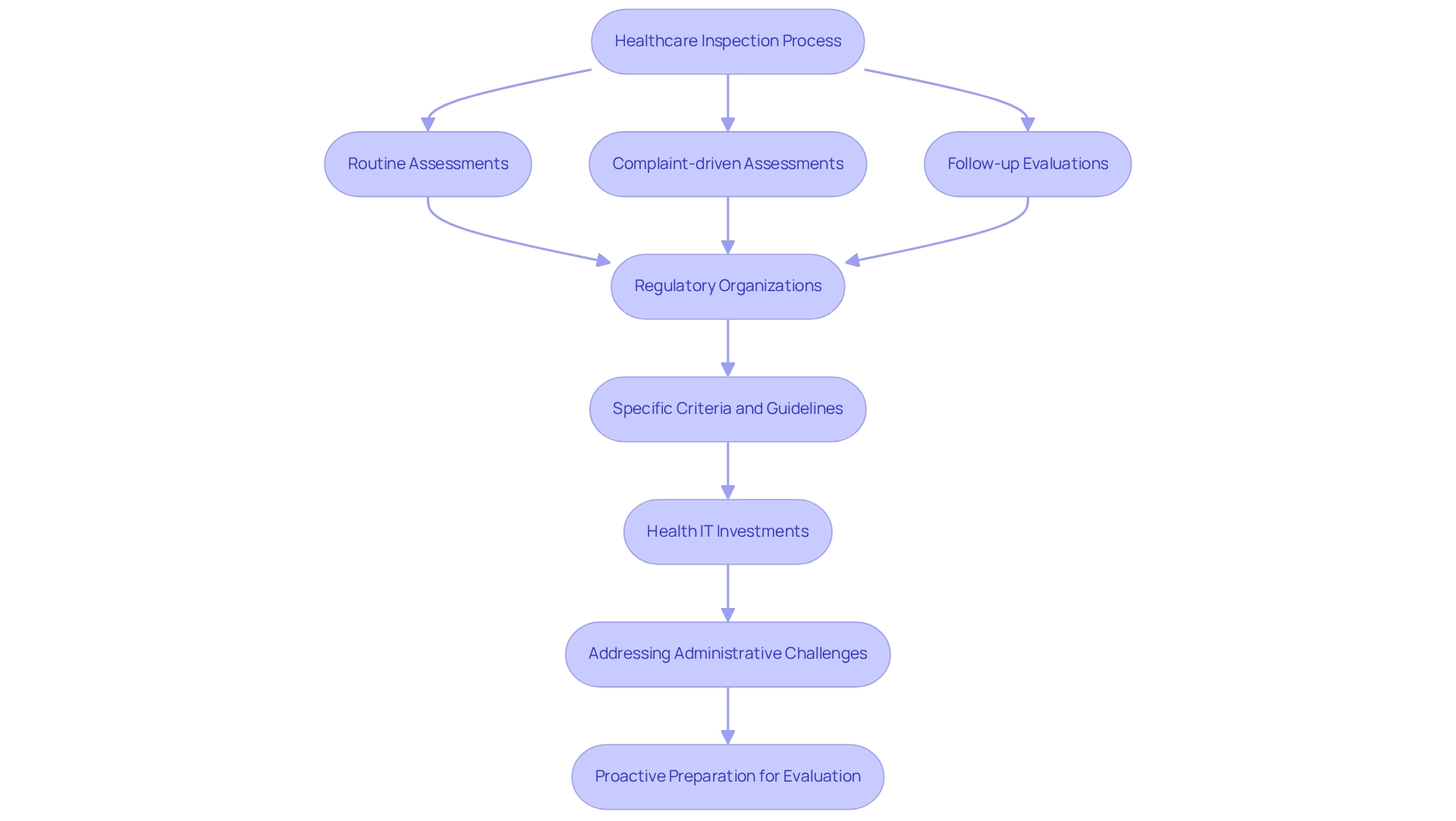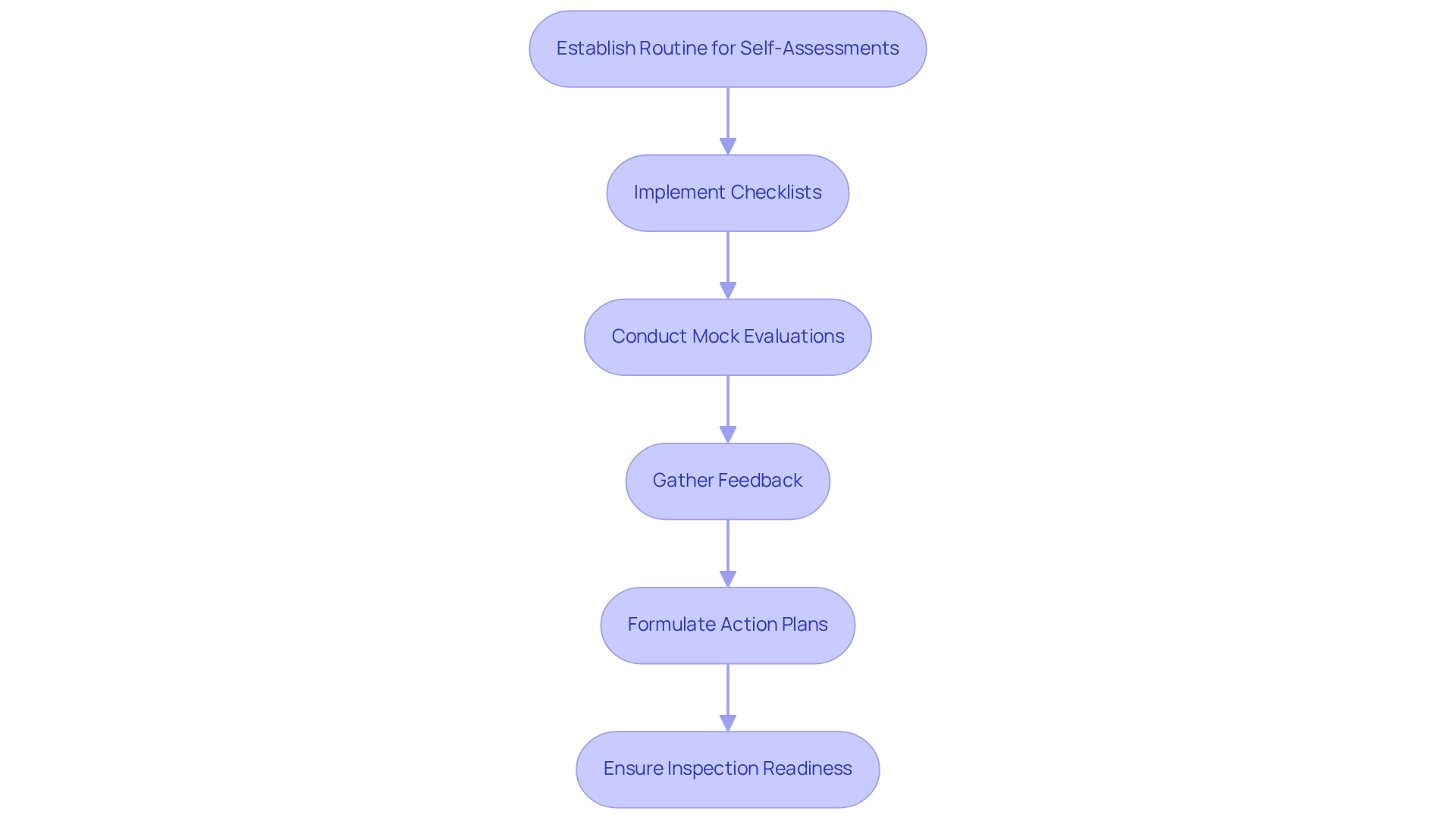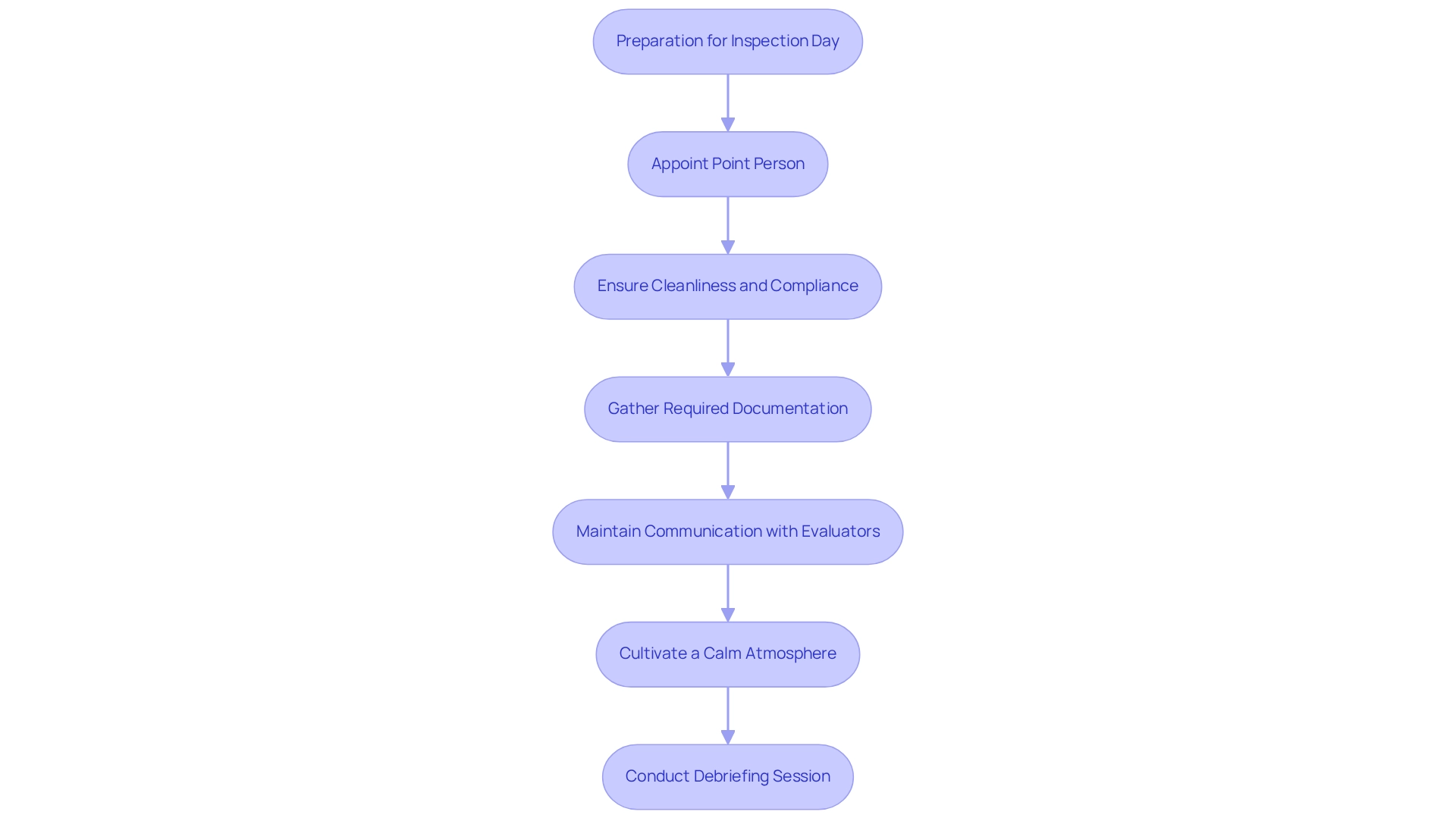Overview
To ensure your facility is inspection-ready, understanding the healthcare inspection process is essential. This includes:
- Preparing thorough documentation
- Conducting self-assessments
- Managing the inspection day effectively
Familiarity with evaluation criteria is crucial, as is the proactive training of staff. Ongoing self-evaluations significantly enhance compliance and operational efficiency. Ultimately, these practices lead to improved patient care and successful inspection outcomes. By implementing these strategies, facilities can not only meet regulatory standards but also foster a culture of continuous improvement.
Introduction
In the intricate world of healthcare, the stakes are high when it comes to maintaining compliance and ensuring quality patient care. Inspections play a critical role in this process, serving as a mechanism for regulatory bodies to uphold standards and improve facility operations. Understanding the healthcare inspection process is not merely about passing a test; it’s about creating a culture of readiness that prioritizes patient safety and operational excellence. Each step—from preparing essential documentation and training staff to conducting self-assessments and managing the inspection day effectively—contributes to a facility’s overall success.
As healthcare organizations navigate the complexities of regulations and strive for continuous improvement, the insights shared in this article provide a roadmap for achieving inspection readiness and enhancing the quality of care delivered to patients.
Understand the Healthcare Inspection Process
To ensure your establishment is inspection ready for evaluation, it is crucial to understand the healthcare assessment process comprehensively. This includes familiarizing yourself with the various categories of assessments:
- Routine
- Complaint-driven
- Follow-up evaluations
Each serving distinct roles in maintaining healthcare standards. Regulatory organizations, such as the Centers for Medicare & Medicaid Services (CMS) and The Joint Commission, play vital roles in overseeing these evaluations, ensuring compliance with established guidelines.
Examining the specific criteria and guidelines pertinent to your facility type is essential. This encompasses safety protocols, patient care standards, and documentation requirements that must be met to successfully pass evaluations. Recent statistics reveal that hospitals have made substantial investments in upgrading their health IT systems, with average expenditures reaching $411,000. These investments are critical; robust health IT systems not only aid in adhering to regulatory standards but also make the organization inspection ready for assessments. Moreover, addressing administrative challenges is essential for improving assessment outcomes. Insights from case studies indicate that aligning regulatory requirements and expediting automation in administrative processes can liberate resources, allowing healthcare providers to concentrate more on patient care instead of paperwork. This shift can ultimately lead to improved compliance and superior patient care.
Furthermore, consider participating in workshops or training sessions focused on evaluation readiness. These opportunities can provide deeper insights into the evaluation process and equip your team with the necessary knowledge to navigate regulatory requirements effectively. By proactively preparing for evaluations to be inspection ready, facilities can enhance compliance and improve overall patient care and operational efficiency, which is vital for successful market access strategies.

Prepare Documentation and Train Staff
Begin by compiling all necessary documentation to ensure it is inspection ready, which includes policies, procedures, and training records. It is crucial that these documents are inspection ready, current, and reflect the latest regulations to ensure compliance and operational efficiency. Establish a centralized area for convenient access during the review process.
Next, conduct training sessions for all staff members to make them inspection ready by familiarizing them with evaluation protocols, expectations, and their specific roles during the assessment. Utilize real-life scenarios and past inspection reports to illustrate common pitfalls and best practices, reinforcing the importance of thorough preparation.
Encourage employees to inquire and clarify any doubts, promoting a culture of adherence and preparedness that is vital for success.

Conduct Self-Assessments and Mock Inspections
Establishing a routine for self-assessments is essential for evaluating compliance with current regulations and standards. Implement checklists aligned with evaluation criteria to conduct thorough assessments across all sections of your facility. Additionally, conducting mock evaluations that replicate the actual assessment procedure can significantly enhance readiness. Involving staff in these simulations allows them to practice responding to inquiries and demonstrating compliance effectively.
Following each practice evaluation, gather feedback and formulate action plans to address any identified deficiencies. This proactive approach not only equips personnel with vital skills but also ensures that your facility is inspection ready, instilling confidence in its overall preparedness for evaluations.
Regular self-evaluations and practice reviews have been shown to enhance adherence rates and elevate the quality of laboratory services, leading to improved review outcomes. Furthermore, as highlighted in the case study ‘Ongoing Inspection Readiness,’ proactive preparation enhances assessment results and supports the delivery of high-quality laboratory services.
Consistently evaluating and updating Standard Operating Procedures (SOPs) minimizes the risk of non-compliance with evolving regulations, underscoring the importance of continuous self-assessments and simulated evaluations as integral components of a comprehensive compliance strategy. By engaging in self-evaluations, organizations can ensure they are well-prepared for evaluations, resulting in enhanced operational efficiency and superior patient care.

Manage the Inspection Day Effectively
On review day, it is imperative that all personnel fully understand their specific roles and responsibilities.
- Appoint a designated point person to welcome the inspectors and guide them through the facility.
- Given that cafeterias typically experience a higher average number of health code violations than all other restaurant categories combined, meticulous preparation is essential to avert common pitfalls.
- Ensure that the environment is inspection ready by maintaining cleanliness, organization, and compliance with safety standards.
- Additionally, all required documentation must be readily accessible for evaluation, as this significantly influences the outcome of the review.
Maintain open lines of communication with the evaluators, addressing any inquiries or issues promptly. It is crucial to cultivate a calm and professional atmosphere among staff, reminding them to respond to questions honestly and to the best of their knowledge.
As noted by Xitong Li, merchants must recognize the impact of previous reviews and develop effective strategies to maximize benefits from promotional deals; this principle can be applied to staff training on managing inquiries during evaluations.
Following the evaluation, conduct a debriefing session to review findings and identify areas for improvement. This reflective practice not only enhances future evaluation readiness but also ensures that the facility remains inspection ready while contributing to ongoing quality enhancement.
Notably, a model accounting for 34.15% of the total variation in inspection scores highlights the necessity of upholding high standards during inspections, reinforcing the importance of diligent preparation and effective communication.

Conclusion
The healthcare inspection process stands as a critical component in ensuring compliance and enhancing the quality of patient care. Understanding the nuances of various inspection types—such as routine and complaint-driven inspections—is essential for healthcare facilities aiming to maintain high operational standards. By investing in robust health IT systems and addressing administrative burdens, organizations can streamline their compliance efforts, allowing them to focus more on patient care. Training staff and preparing documentation are vital steps in this journey, fostering a culture of readiness and compliance that permeates the facility.
Conducting regular self-assessments and mock inspections further equips teams to handle actual inspections with confidence. These practices not only identify areas for improvement but also reinforce the importance of ongoing training and adherence to evolving regulations. On inspection day, effective management, clear communication, and a calm atmosphere are paramount in demonstrating compliance and operational excellence.
Ultimately, the commitment to understanding and preparing for healthcare inspections transcends merely passing a test; it is about instilling a culture that prioritizes patient safety and operational integrity. By adopting a proactive approach to inspection readiness, healthcare facilities not only improve their compliance outcomes but also enhance the overall quality of care they provide to patients, ensuring their success in a highly regulated environment.

